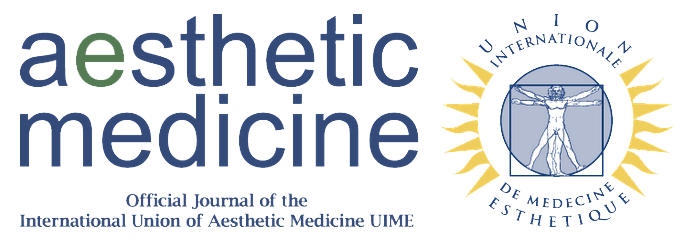Efficacy of emerging therapies versus traditional therapies in the treatment of hypertrophic scars and keloids: a systematic review
Keywords:
Hypertrophic scars, Keloids, Regenerative therapies, Mesenchymal stem cells, Platelet-rich plasmaAbstract
Introduction: Hypertrophic scars and keloids are abnormal wound-healing alterations that disproportionately affect populations of African, Asian, and Latin descent. Traditional therapies, such as surgery, corticosteroids, and laser treatments, demonstrate limited effectiveness and frequent recurrence. Emerging therapies, including mesenchymal stem cells and growth factors, hold promise for improved inflammatory regulation and tissue remodeling.
Objective: To compare the efficacy and safety of emerging therapies versus traditional treatments in reducing hypertrophic scars and keloids, evaluating aesthetic outcomes, scar size, and recurrence rates.
Methods: A systematic review was conducted in accordance with PRISMA guidelines, including 8 studies with 525 participants. The interventions assessed comprised mesenchymal stem cells, platelet-rich plasma, and triamcinolone-laser combinations. Primary outcomes were volume reduction, aesthetic improvement, and decreased recurrence.
Results: Emerging therapies, such as platelet-rich plasma, showed significant reductions in the Vancouver Scar Scale (p<0.05) and decreased profibrotic markers such as CTGF (40%-50% reduction). Traditional treatments, like intralesional triamcinolone, achieved an average scar volume reduction of 90.1% within one year (p=0.031) but were associated with greater adverse effects, such as hypopigmentation. Combined therapies offered improved aesthetic results with a lower incidence of side effects.
Discussion: Emerging therapies demonstrate significant potential, particularly in reducing profibrotic factors and achieving an initial aesthetic improvement. However, they present limitations regarding standardization and long-term sustainability. Traditional therapies, while effective, require combinations to minimize recurrence and adverse effects.
References
1. Zaballos P, Morales AL, Navarro AC, Salsench E, Garrido AM, Montañés JA. Consulta diaria. Que haría usted ante queloides y cicatrices hipertróficas. Med Integral. 2001; 38(9):385-9.
2. Andrades P, Benítez S, Prado A. Recommendations for the management of hypertrophic scars and keloids. Rev Chil Cir. 2006; 58(2):78-88.
3. Guerrero-Rincón AD, Cuellar-Sánchez MA, Santana-Partida SA, et al. Updates in the management of hypertrophic and keloid scars: a systematic review. Rev Colomb Cir Plástica Reconstr. 2024; 30(1):18-27
4. Haghani-Dogahe Z, Hadadi R, Esmailzadeh M, Mobayen M. Comparing intralesional triamcinolone and verapamil-triamcinolone injections in keloids: a single-blinded randomised clinical trial. Int Wound J. 2023; 20(10):4166-4174.
5. Jafarzadeh A, PourMohammad A, Goodarzi A. A systematic review of the efficacy, safety and satisfaction of regenerative medicine treatments, including platelet-rich plasma, stromal vascular fraction and stem cell-conditioned medium for hypertrophic scars and keloids. Int Wound J. 2024; 21(4):e14557.
6. Tawaranurak N, Pliensiri P, Tawaranurak K. Combination of fractional carbon dioxide laser and topical triamcinolone vs intralesional triamcinolone for keloid treatment: a randomised clinical trial. Int Wound J. 2022; 19(7):1729-1735.
7. Neinaa YME, Elsayed TA, Mohamed DA, Elfar NN. Botulinum toxin and platelet rich plasma as innovative therapeutic modalities for keloids. Dermatol Ther. 2021; 34(3):e14900.
8. Fang F, Huang RL, Zheng Y, Liu M, Huo R. Bone marrow derived mesenchymal stem cells inhibit the proliferative and profibrotic phenotype of hypertrophic scar fibroblasts and keloid fibroblasts through paracrine signaling. J Dermatol Sci. 2016; 83(2):95-105.
9. van Dongen JA, van Boxtel J, Uguten M et al. Tissue stromal vascular fraction improves early scar healing: a prospective randomized multicenter clinical trial. Aesthet Surg J. 2022; 42(7):477-488.
10. Ren Y, Zhou X, Wei Z, Lin W, Fan B, Feng S. Efficacy and safety of triamcinolone acetonide alone and in combination with 5-fluorouracil for treating hypertrophic scars and keloids: a systematic review and meta-analysis. Int Wound J. 2017; 14(3):480-487.
11. Behera B, Kumari R, Thappa DM, Malathi M. Therapeutic efficacy of intralesional steroid with carbon dioxide laser versus with cryotherapy in treatment of keloids: a randomized controlled trial. Dermatol Surg. 2016; 42(10):1188-1198.
12. Khalid FA, Mehrose MY, Saleem M et al. Comparison of efficacy and safety of intralesional triamcinolone and combination of triamcinolone with 5-fluorouracil in the treatment of keloids and hypertrophic scars: randomised control trial. Burns. 2019; 45(1):69-75.
13. Son IP, Park KY, Kim B, Kim MN. Pilot study of the efficacy of 578 nm copper bromide laser combined with intralesional corticosteroid injection for treatment of keloids and hypertrophic scars. Ann Dermatol. 2014; 26(2):156-161.
Downloads
Published
Issue
Section
License
Copyright (c) 2025 Juan Alzate, Johanna Villamil-Guevara, Juliana Adarme-Malaver, Laura Gutiérrez-Ochoa , Laura Acevedo Piedrahita , Mariana Pinilla-Obregon

This work is licensed under a Creative Commons Attribution-NonCommercial 4.0 International License.
This is an Open Access article distributed under the terms of the Creative Commons Attribution License (https://creativecommons.org/licenses/by-nc/4.0) which permits unrestricted use, distribution, and reproduction in any medium, provided the original work is properly cited.
Transfer of Copyright and Permission to Reproduce Parts of Published Papers.
Authors retain the copyright for their published work. No formal permission will be required to reproduce parts (tables or illustrations) of published papers, provided the source is quoted appropriately and reproduction has no commercial intent. Reproductions with commercial intent will require written permission and payment of royalties.

This work is licensed under a Creative Commons Attribution-NonCommercial 4.0 International License.





